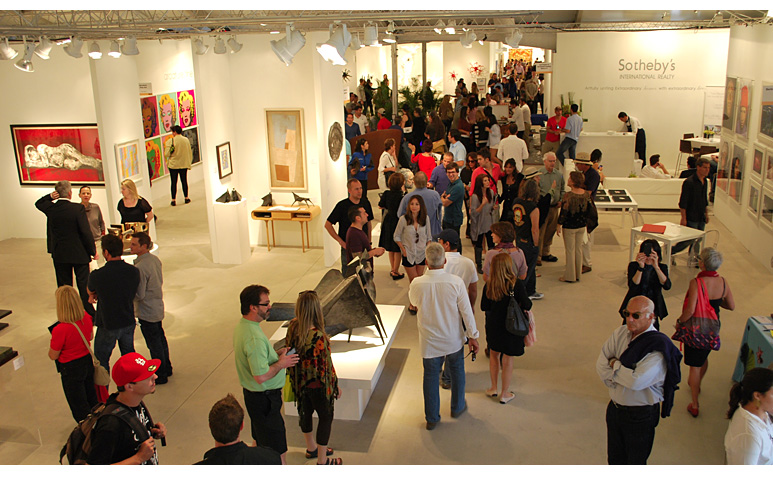 Art Miami 2012. Courtesy Art Miami, LLC.
Art Miami 2012. Courtesy Art Miami, LLC.
I love going to Contemporary Art Fairs. These are almost like the trade shows of contemporary art. There are paintings and galleries from all over the world. There are a zillion different kinds of paintings, photographs and sculptures strewn through baseball field size buildings with thousands of artists, buyers and art enthusiasts wandering amongst the displays. It often takes more than one day to see all the work.
It is inspiring to go. But it is especially so when you have some of your own work there. It allows the artist to see his or her art in context with everyone else’s. I remember when I went and finally came across my own work, for a second or two I hardly recognized it. After seeing everyone else’s art, I had achieved a measure of objectivity. Something that, upon later reflection, was incredibly valuable.
I stood there looking at my work, then back again at all the other work surrounding it – some good, some great and, of course, some not so good, but all of it provided context.
And then I got it – right there I had somewhat of an epiphany about what makes art – especially at these fairs, stand out.
There are basically three qualities, which I wrote down on the back of the Fair guide they gave me when I walked in.
1 The Art is Unique.
It is not hard to spot, at these fairs, which art is really drawing viewers in because today, people tend to wait in line to photograph it with their phone. They are voting with their phones and amazingly it is the same few paintings or sculptures that gain this attention. Without exception, this artwork being photographed is totally unique and unlike anything else surrounding it. I cannot stress enough how consistently work that is different and unique almost triggers human beings to want to engage. People are simply drawn to what makes them feel something they haven’t before.
2 The Art is Simply, Complex.
Another aspect I notice about remarkable work is that it is not accomplishing or showing a whole variety of ideas within the same work. It is not that the work is not complex; rather it is just that it looks relatively simple from a distance. The artist has chosen to clearly – and that is the operative word – not only say one thing but to do so very, very powerfully. Often there is just a couple of things going on, whether it is texture, shapes, color, line, etc., that are in contrast to one another. Interestingly, if something is communicated very simply, if the idea is clear, then suddenly there is an opportunity for quiet complexity to slip in beside this powerful, singular art statement and coexist. You end up with a seemingly simple, powerful visual that grows in complexity and sophistication the longer you look at it. “Something about this one…. I just can’t quite walk past it. Maybe I better just take a picture so I can hold it in my life longer.”
3 The Art Feels it is Made Without Trying.
Easier said than done, but work that rises to the surface at these fairs does demonstrate the artist’s mastery of their chosen materials. The artist doesn’t have to necessarily master their materials but at the same time the materials cannot be the master of the artist either. In other words – and this can be subtle – the viewer should not be able to feel tentativeness in any way on the part of the artist when using their chosen materials. We want to feel a direct connection between the artist and what they are thinking or doing. Seeing marks that are only half committed, or the evidence of materials that are overly controlled out of indecision can often be a barrier for the viewer to really get the impact of what the artist was trying to say. When the Art looks like it has been made without excessive effort, then we get the sense as viewers that this particular artist has these materials so down that she can spend her attention and focus on giving us a super potent distillation of who she is and what she is communicating as an artist, above and beyond the materials. That is truly a gift for a viewer and as such, whether people understand why or not, they are drawn to the work.
There is the tendency to try and game and figure out what makes people become attracted to certain kinds of art. Then, once known, we could just do this particular kind of art and all would be good. Thankfully, making art, as most of you know, is not something you can perfect and duplicate to have home runs every single day for yourself or anyone else for that matter.
But there is one overarching idea that all these qualities, aspects of powerful, highly desirable work, all seem to gather beneath.
And it is this:
Art that can become as truly unique as the individual artist making it will engender a feeling of aliveness in the viewer. And this feeling, this sensation for 99 percent of human beings walking around the planet is highly desirable, enticing, and inspiring.
In gratitude, Nicholas
PS This post happens to be going out the same day as the 2016 Mentorship Invitations! Admission will be closing in less than a week so if you ever wanted your Art to become more like you, then click here for the Mentorship Invitation and Application it will be emailed to you today.



